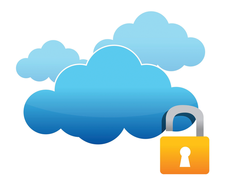Store data securely in the cloud with Cryptomator
Secure Cloud

© Lead Image © alexmillos, 123RF.com
Cloud services often place little value on data encryption. With Cryptomator, you can easily and transparently encrypt your data locally before uploading to the cloud.
Cloud services provide a convenient and cost-effective alternative to local storage, especially for users who want to access their data from anywhere. However, many cloud providers do not pay sufficient attention to data security. They often store unencrypted data in the cloud as well as transferring the data without encryption. This paves the way for hackers to sniff for authentication data to access a cloud account and then spy on the data.
State institutions, such as intelligence services or investigative authorities, can also view this unprotected data. In addition, this kind of sniffing is often legal, especially in countries where data protection is of little importance. Cryptomator [1], a program developed by the German company Skymatic, puts a stop to this data espionage by encrypting your data transparently. Since Cryptomator's source code is licensed under the GPLv3, built-in backdoors are eliminated.
Strategy
Cryptomator works as a local server that processes the data to be encrypted on a virtual drive integrated by the Filesystem in Use (FUSE) module on Linux. If FUSE is not available, the software uses WebDAV instead. Cryptomator always encrypts the data with a 256-bit AES key and a MAC master key, generating the keys using scrypt technology [2]. In contrast to many other cryptographic programs, Cryptomator not only encrypts the file contents, but also their metadata. In addition, it changes the file size, which makes it difficult to draw conclusions about a file's content.
[...]
Buy this article as PDF
(incl. VAT)
Buy Linux Magazine
Subscribe to our Linux Newsletters
Find Linux and Open Source Jobs
Subscribe to our ADMIN Newsletters
Support Our Work
Linux Magazine content is made possible with support from readers like you. Please consider contributing when you’ve found an article to be beneficial.

News
-
TrueNAS 25.04 Arrives with Thousands of Changes
One of the most popular Linux-based NAS solutions has rolled out the latest edition, based on Ubuntu 25.04.
-
Fedora 42 Available with Two New Spins
The latest release from the Fedora Project includes the usual updates, a new kernel, an official KDE Plasma spin, and a new System76 spin.
-
So Long, ArcoLinux
The ArcoLinux distribution is the latest Linux distribution to shut down.
-
What Open Source Pros Look for in a Job Role
Learn what professionals in technical and non-technical roles say is most important when seeking a new position.
-
Asahi Linux Runs into Issues with M4 Support
Due to Apple Silicon changes, the Asahi Linux project is at odds with adding support for the M4 chips.
-
Plasma 6.3.4 Now Available
Although not a major release, Plasma 6.3.4 does fix some bugs and offer a subtle change for the Plasma sidebar.
-
Linux Kernel 6.15 First Release Candidate Now Available
Linux Torvalds has announced that the release candidate for the final release of the Linux 6.15 series is now available.
-
Akamai Will Host kernel.org
The organization dedicated to cloud-based solutions has agreed to host kernel.org to deliver long-term stability for the development team.
-
Linux Kernel 6.14 Released
The latest Linux kernel has arrived with extra Rust support and more.
-
EndeavorOS Mercury Neo Available
A new release from the EndeavorOS team ships with Plasma 6.3 and other goodies.

